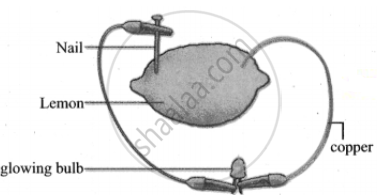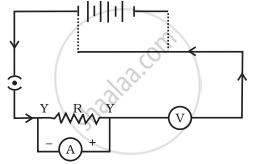Advertisements
Advertisements
प्रश्न
Rahul wants to make an electric circuit. He has a bulb, two wires, a safety pin, and a piece of copper. He does not have any electric cell or battery. Suddenly he gets some idea. He uses lemon instead of a battery and makes a circuit. Will the bulb glow?
उत्तर
Yes, the bulb will glow:
- Take a lemon. Squeeze it without breaking its skin. The squeezing action releases the juice inside the lemon needed as the battery works.
- Use a nail to make one hole in one end of the lemon and push a copper wire into that hole.
- Then, push the nail into the other end.
- Connect a bulb with one of the terminals with the copper wire and the other terminals with the nail, as shown in the figure.
- Now the lemon generates a small amount of electricity and the bulb glows.

APPEARS IN
संबंधित प्रश्न
Draw a schematic diagram of a circuit consisting of a battery of three cells of 2 V each, a 5 Ω resistor, an 8 Ω resistor, and a 12 Ω resistor, and a plug key, all connected in series.
Match the column ‘A’ with column ‘B’.
|
Column ‘A’
|
Column ‘B’ |
|
(1) Eka - boron
|
(a) Germanium
|
|
(2) Eka - Aluminium
|
(b) Scandium
|
|
(3) Eka - Silicon
|
(c) Gallium |
What is open circuit?
If you touch an electric wire carrying current you get a shock, but if on the same wire the birds sit they do not get any shock/current. Explain why?
Draw the circuit diagram for the series connection.
In which among the following circuits does the bulb glow?
Study the three electric circuits below. Each of them has a glass rod (G), a steel rod (S), and a wooden rod (W).
In which of the electric circuits would the bulb not light up.

Assertion: People struck by lightning receive a severe electrical shock.
Reason: Lightning carries very high voltage.
In a circuit, if the key is in open (off) condition, then electricity will not flow.
A child has drawn the electric circuit to study Ohm’s law as shown in Figure. His teacher told that the circuit diagram needs correction. Study the circuit diagram and redraw it after making all corrections.

